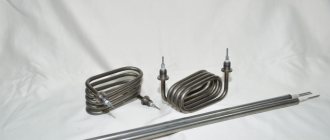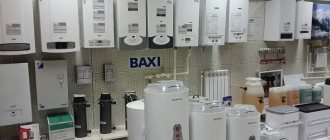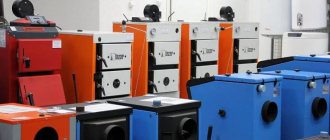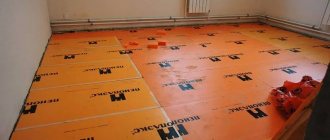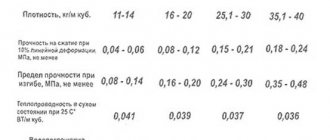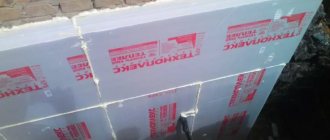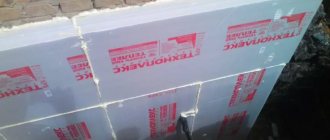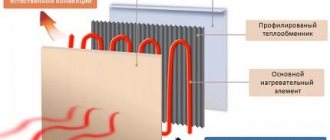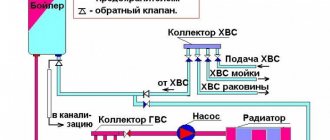The heating panel is used as primary and additional heating in residential and public premises, buildings and structures, children's rooms, preschools and medical institutions.
The possibility of using the panel in various types of premises is due to the low temperature of the heating surface (45–50°C), as well as the fact that moisture-resistant or fire-resistant plasterboard is used as the basis of the heating panel. The thickness of the drywall used can vary (8.0; 9.5; 12.5 mm).
Features of infrared drywall
The dimensions of the heating panel correspond to the dimensions of the plasterboard sheets used during installation. The panels have special markings for fastening, ensuring ease and convenience of installation. Attaching a heating panel to profiles is no different from attaching a regular sheet of drywall.
On the back side of the heating panel there are insulated terminals for connecting to the power supply.
The possibility of hidden and open installation is provided. For installation, the heating panel kit includes electrical contact leads to the front of the device, and the device itself has a hole for bringing the contacts out. In case of open installation, contacts are brought out under the plinth, providing easy access to them and without disturbing the original design of the room.
The safety of the devices during transportation is guaranteed by packaging and special placement of the devices. The devices are packaged in protective film and placed in sealed corrugated boxes in a set of 2 pieces.
effect-ik.ru
How do GPK heating panels work?
Externally, these panels are similar to the simplest thin sheet of plasterboard measuring 60 × 60 cm. But this simplicity is only external. A film made of a special polymer consisting of a carbon composite is mounted inside the gypsum sheet.
The back of the panel is protected by a heat-insulating layer and is also equipped with a cord for connecting to the power supply.
These panels can be safely used for covering walls and ceilings; they can be combined into one common system. The plates are heated from the inside and emit infrared waves, while consuming 100 Wh to heat 1.5 m² of area. It is difficult to call this technology literally energy-saving. The carbon polymer film inside GPC batteries does not melt, does not oxidize, and does not burn. The room temperature can be adjusted using a simple device that is mounted separately from the panels on the wall.
The control unit can turn the panels on and off at the time you need
Possibility of using Revolts panels
Revolts infrared plasterboard panels can be used as the main or additional means of heating residential premises. They can also be installed in public buildings, including children's and medical institutions. If the heating quality is insufficient or during the off-season, IR panels can be used in apartments with centralized heating. This additional heating will be especially appropriate in children's rooms and cold corner rooms.
Revolts plasterboard panels are very convenient and beneficial when installing heating in a private home.
This type of heating will help if gas is not supplied to the site. Also, if the operation of the house is seasonal, then the low cost of Revolts panels will compare favorably with the installation costs of any other type of heating.
Operating principle of infrared plasterboard panels
"Revolts" are plasterboard panels that generate heat due to infrared heat waves. The waves heat not so much the air itself as the objects in the room. This allows you to heat the room evenly and gently. The temperature of the heating surface is about 40 – 50 ˚С, which is very comfortable: it does not dry out the air and minimizes convective currents.
With the help of Revolts heating panels you can completely heat a room.
Advantages and disadvantages
Like any other heating system, Revolts plasterboard boards have their advantages and disadvantages. Of course, for each of the factors influencing the choice in favor of this particular heating method, an assessment should be made based on where the installation will be made, for what purpose, and in what mode of operation it is planned.
Advantages of plasterboard heating "Revolts"
- Easy to install. The infrared panel is installed in the same way as regular drywall. You can install Revolts into a wall or ceiling when creating a gypsum plasterboard wall, or you can simply hang it outside the wall. In this case, the installation time will require no more than the installation of, for example, an oil heater.
- No approval required for installation. This is a significant difference between plasterboard panels and gas equipment.
- No maintenance required. Water filling systems require regular inspection, fluid replacement and similar measures. There are no components in electrical equipment that require the same level of attention.
- Space saving. The panels save space both on the walls (unlike radiator heating) and in the height of the room (unlike built-in heated floors of any kind).
- Durability. The panels are very simply designed and therefore do not have parts that can quickly fail.
- High heating rate. This property applies to all electric heating systems.
- Possibility of gradual payment for a home heating system. This means that the installation of heating panels can be carried out, for example, as repairs are carried out in different rooms of the house. Any other heating system requires simultaneous installation in the entire apartment or house, which involves significant one-time costs.
- Clean installation. Dust and dirt accompany the installation of even radiator heating, not to mention heated floors. But dirt does not form when installing IR panels. The maximum that will get dirty is cutting the plasterboard sheets mounted together with the panels, as well as their putty for further finishing.
- Versatility. Plasterboard panels can be installed in any room.
- Safety. The use of Revolts infrared plasterboard panels is comparable in operating hazard to conventional electrical wiring. They also cannot be frozen like water radiators and underfloor heating pipes.
Disadvantages of plasterboard heating "Revolts"
- High requirements for electrical safety. You need to be careful about the diameter of the wires for connecting the panels to the network. If the diameter is insufficient, the joints will heat up, and this can lead to a fire.
- Large maximum power consumption. When using Revolts heating panels as your main heat source, your electricity bills will be high at high loads. To avoid this, the building must be very well insulated.
It should be noted that the disadvantages of such panels can be minimized. You just need to use good thermal insulation and install it on a wire of sufficient diameter. In addition, the advantages of the Revolts heating system are much greater than the disadvantages.
How to install a Revolts heater system
The most common installation option is ceiling; experts recommend installing plasterboard boards on the ceiling, as is done when installing conventional ceiling cladding.
The main requirement for installing Revolts heating panels is to insulate the concrete ceiling, otherwise half of the heat will go into the concrete. In this case, it is not necessary to sew on foam plastic boards; it is enough to nail a layer of OSB boards onto the dowels, after which you can install the profile and fasten the Revolts heaters with self-tapping screws, like regular drywall.
The second option involves installing heating panels on the walls of rooms; most often, the heaters are mounted at a height of 20-30 cm above the floor, like conventional convectors or radiators.
In this case, there is no loss of useful space due to the suspension of heat convector radiators, you can get rid of pipes, and there is no need to break through channels for laying separate wiring, as when using any electric heaters. In this case, there is no need to lay out the entire ceiling or walls with Revolts panels; for one square of usable area of the room, 0.7 square meters of heating surface will be required, or vice versa, 1 m2 of drywall can heat 1.3 m2 of the room.
The panels can also be laid into the base of the floor covering in the same way as a warm floor. In this case, the heat transfer coefficient is reduced due to an additional layer of laminate or parquet flooring, but in general, the quality of heating increases due to more rational heat distribution.
Methods for installing Revolts heating panels
Revolts plasterboard heating panels can be installed in hidden or open ways.
Can be installed both on walls and ceilings.
Connection of several panels to the electrical network is carried out in parallel.
In the hidden method, IR panels are built into the wall. The dimensions of the Revolts heating panel are 600 mm by 600 mm, which corresponds to the usual pitch of the metal profile on which plasterboard sheets are mounted. The panels are marked for fastening, which makes installation easy and convenient.
With the open method, the panel can be hung in any convenient place. If the fastening is carried out using furniture lugs, and plugs are connected to the wire, then you can use the panel as a suspended heater. By the way, by decorating the front part of the panel with a beautiful picture, you can very successfully fit such an additional heating device into the interior.
mrgipsokarton.ru
Official manufacturer of plasterboard heating panels Revolts
The Revolts plasterboard heating panel is used as basic or additional heating. These panels can be used to heat almost any type of premises in compliance with safety rules. Apartments, cottages, sports facilities, administrative and office premises, trade and exhibition complexes, service premises and much more.
Use the infrared plasterboard heating panel exclusively for its intended purpose as specified in the operating instructions.
The connection must be made only by professional craftsmen in accordance with the “Rules for the construction of electrical installations” and the “Safety rules for the operation of electrical installations”.
Installation of plasterboard heat supply panel.
The plasterboard heat supply panel consists of a specific plasterboard board, onto which a special heat-composite developed by the TEN company is pressed, thanks to which a significant part of the heat goes to heating the plasterboard board, there is also a reflector at the back of the panel for better operation of the panel, on the back of the panel there are connecting wires, On the front part of the panel there are markings (fields) into which self-drilling screws can be screwed for fastening to the guide profiles at the time of installation.
Connection instructions
- Several panels are connected in PARALLEL. (polarity does not matter)
- Wire cross-section for connection to panels 1.5 square
plasterboard heating REVOLTS
To prevent panel failure and overheating, use a thermostat.
- Plasterboard heat supply panel 10 pcs.
- Instruction manual 1 pc.
- Cardboard packaging 1 pc.
- The thermostat is not included in the set (purchased separately).
- Model: IGPO 600*600 REVOLTS
- Voltage: 220 V
- Radiation wavelength, microns 8-10
- Power, W 100
- Heating temperature of the front wall of the panel +55C
- Dimensions, mm - 600 * 600 * 12
- Weight, kg - 1.8
- Suspension height, m — 2–3
Operation and maintenance.
The plasterboard heating panel does not require maintenance.
Heat supply plasterboard panels should be stored in their original packaging, in a room with a temperature range of - 25C to +50C, with a moisture content of no more than 65%.
The manufacturer guarantees the absence of defects in the operation of the product for 10 years from the date of purchase.
If during this warranty period the product is found to be defective due to the fault of the manufacturer, it will repair the product free of charge or replace it if there is a sales stamp.
Attention! The manufacturer reserves the right to modernize the product without compromising its main parameters. All rights to the product are marked and reserved
All rights to the product are noted and reserved.
For apartments
“REVOLTS” infrared heating panels will be a reliable source of additional heat in apartments with central heating, where walls or ceilings are planned to be finished with plasterboard.
The system will help keep you warm during the off-season and eliminate the need to constantly move floor electric heaters from place to place.
When using panels as an additional source of heating, it is enough to install several panels with a total power of 50% of the calculated power for the room.
Useful tips for using thermal panels
When making a firm decision to use plasterboard panels, you should heed the following recommendations:
- The most suitable place to mount the device is the middle side of the wall or the ceiling. In offices or rooms where sitting predominates, installation of panels is recommended no more than 80 cm from the workplace;
- a corridor, kitchen or bathroom can be equipped with a plasterboard heating system only in the ceiling. Given a low ceiling, if the opposite situation is present, then the use of the equipment will not have a positive effect. Then it makes sense to consider installation using “warm floor” technology;
Infrared panels
- ideal efficiency is observed in rooms no more than 2.5 m wide. Narrow passages are simply not capable of accumulating heat, and passages that are too wide will not warm up completely;
- due to the general operation of the heating device on electric current, it is worth taking care of alternative heating during a lack of electricity in the event of force majeure;
- Due to the operation of plasterboard heating, it is irrational to heat large rooms in this way. The technology has a positive effect on creating unique comfort zones in children's rooms, in the computer area or for recreation areas.
But still, despite the general disadvantages, such heaters are able to provide the necessary heat during the off-season, when the general air temperature is quite low and there is no central heating yet. The panels performed well in country houses and dachas.
Installation
The dimensions of the REVOLTS heating panel correspond to dimensions 600*600. The panels have special markings for fastening, ensuring ease and convenience of installation.
Attaching a heating panel to profiles is no different from attaching a regular sheet of drywall.
Comfort technology
Unlike convector-type heaters (including central heating radiators), REVOLTS heating panels transfer heat through infrared heat waves. Such warmth is similar to the warmth of a fire, fireplace, Russian stove and the sun - the main heater of our planet.
This property of the infrared panel system allows:
- Rationally distribute the temperature across the height of the room. Warm up the floor space without overheating the air at head level.
- Maintain the necessary air humidity and freshness in the room.
- Heat the walls, floor, interior items and the person himself, minimizing convective air currents (drafts) that raise dust and create discomfort.
- Distribute heat evenly throughout the room with the temperature of the heating surfaces (45-50C) close to human body temperature.
These features of the system allow you to create your own microclimate in the room, the most favorable conditions for human living and activity.
Energy saving. Energy Saving Technologies
- REVOLTS infrared panels are connected to an automatic thermostat that controls the air temperature, which allows you to turn on the system only as needed and maintain optimal temperature conditions in each individual room.
- The system avoids excessive heating of the air, while the temperature between the floor and ceiling is equalized.
- Heat accumulates in objects and walls; heated objects, in turn, release the accumulated heat into the room.
- Thanks to the uniform placement of infrared heating panels, the room warms up much faster.
Infrared panels are energy-saving technologies.
Energy savings from 30 to 50%. Wide range of design and design possibilities
The use of infrared heating panels "REVOLTS" as the main and additional heating allows you to get rid of pipes, radiators and other utility networks used in traditional heating.
The panels can be placed both on the walls and on the ceiling or only on the ceiling, i.e. where it is convenient and necessary. In this case, the efficiency of the heating system will not be affected in any case.
The presence of the system will only be indicated by a thermostat located in a convenient location on the wall. The low heating temperature of drywall (40-50C) allows for any fine finishing of the surface (wallpaper, tiles and various decorative materials).
Safety and durability
Infrared heating panels "REVOLTS" are made of environmentally friendly materials and are absolutely fireproof. The components for the heating panel have been selected and tested for many years.
Despite the simplicity of the panel, it is a complex complex of correctly selected materials and components due to which this panel has high performance characteristics. The operation of the panels is permitted as the main heating system without supervision.
The durability of heating panels is due to the simplicity of the design, the almost unlimited service life of the materials used in production (moisture-resistant drywall), as well as the low temperature of the special heating element.
remontyes.ru
zen.yandex.ru
Plasterboard heat supply "Revolts": an economical solution for heating a home
If we talk about classical sources of energy, they can be divided into three types:
- electric heating;
- gas heating;
- heat supply by burning solid and liquid fuels (wood, coal, gasoline, etc.).
There are other, less popular sources of energy. They are called alternative.
In the field of electric heating, a separate niche is occupied by Revolts plasterboard heat supply. These are slabs of classic size 600 by 600 mm. There is space for fastening on the panel along the perimeter. The slabs are installed in a closed manner simultaneously with plasterboard cladding on the walls, floor, and ceiling. They can also be used openly, as a spot heating device.
Working principle of infrared plasterboard panels
"Revolts" are plasterboard panels that emphasize warmth through infrared heat waves. The waves heat not so much the air itself as the objects in the room. This makes it possible to heat the room equally and gently. The temperature of the heating surface is about 40 – 50? C, which is quite convenient: it does not dry out the air and reduces convective flows.
With the help of Revolts heating panels you can completely heat a room.
Possibility of using Revolts panels
Infrared panels made from Revolts plasterboard can be used as the main or additional means of heating residential premises. They can also be installed in public buildings, including children's and medical institutions. If the quality of heating is insufficient or during the off-season, IR panels can be used in apartments with traditional heating. This additional heat supply will be especially appropriate in children’s rooms and cold corner rooms.
Revolts plasterboard panels are quite convenient and beneficial when installing heat supply in a private house.
This type of heating will help if gas is not supplied to the area. Also, if the work at home is seasonal, then the low price of Revolts panels will compare favorably with the installation costs of any other type of heating supply.
Advantages and disadvantages
Like any other heating system, Revolts plasterboard slabs have their own positive and negative qualities. Of course, for any of the factors influencing the choice for the benefit of this particular heating option, it is necessary to make an assessment taking into account where the installation will be carried out, for what purpose, in what mode the operation is expected.
Advantages of plasterboard heat supply "Revolts"
- Easy to install. The thermal panel is installed in the same way as simple drywall. You can build Revolts into a wall or ceiling when creating a plasterboard wall, or you can simply hang it on the outside of the wall. In this case, installation time will be required less than the installation of, for example, an oil heater.
- No approval required for installation. This is a significant difference between plasterboard panels and equipment that runs on gas.
- No maintenance required. Water filling systems require constant checking, fluid replacement and similar measures. There are no elements in electrically powered equipment that require the same amount of attention.
- Space saving. The panels save space both on the surface of the walls (unlike radiator heating) and at room height (unlike built-in heated floors of any kind).
- Durability. The panels are quite easily constructed and therefore do not have parts that can quickly break.
- High heating speed. This property applies to all electric heating systems.
- Possibility of slow payment for the home heating system. This means that the installation of heating panels can be carried out, for example, as repairs are carried out in various rooms of the house. Any other heating system requires a simultaneous installation process throughout the entire living space or house, which involves significant one-time costs.
- Clean installation. Dirt and dust accompany the installation of even radiator heating, not to mention heated floors. But dirt does not appear when installing IR panels. The most that will get dirty is cutting the plasterboard sheets installed simultaneously with the panels, as well as their putty for subsequent cladding.
- Multifunctionality. Plasterboard panels can be installed in a variety of rooms.
- Safety. The use of Revolts infrared plasterboard panels is similar in terms of the danger of operation with ordinary electrical wiring. Also, they cannot be preserved like water-fired radiators and heated floor pipes.
Which adhesive to choose for plaster: advice from an expert
Disadvantages of plasterboard heat supply "Revolts"
- Great requirements for electrical safety. It is necessary to take seriously the diameter of the wires for connecting the panels to the network. If the diameter is insufficient, the joints will heat up, and this can lead to fire.
- Large maximum power consumption. When using Revolts heating panels as the primary heat source at high loads, your electricity bills will be high. To prevent this, you need to insulate the building quite well.
It should be noted that the disadvantages of such panels can be completely reduced to a minimum. It is only necessary to use excellent thermal insulation, and install it on a wire of sufficient diameter. Moreover, the positive qualities of the Revolts heating system are much higher than the negative ones.
Methods of panel installation of heat supply Revolts
Revolts heat supply plasterboard panels are installed in hidden and open ways.
Can be placed both on walls and on ceiling surfaces.
It is possible to install Revolts heating panels not only on walls, but also on the ceiling surface.
Connecting several panels to the electrical network is carried out in parallel.
With the hidden method, IR panels are built into the wall. The dimensions of the Revolts heating panel are 600 mm by 600 mm, which corresponds to the usual pitch of corrugated sheets on which plasterboard sheets are installed. The panels have markings for fasteners, making installation easy and convenient.
With the open method, the panel can be hung in any comfortable place. If the fasteners are made using furniture lugs and plugs are connected to the wire, then you can use the panel as a suspended heating device. By the way, by decorating the front panel with a beautiful picture, you can quite successfully include such an additional radiator design in the design.
Working principle and scope of application of infrared heat
Infrared heating devices operate on a principle borrowed from the sun - the waves they emit heat objects, and the heat is gradually transferred from the heated surfaces to the air. Comfort in the room is felt already at 15 degrees, which cannot be achieved with electric convectors and water batteries. Using various types of heaters, you can not only quickly heat a building of any type, but also organize local heating of a separate area on the street.
To understand why radiant heat instantly creates comfortable conditions, it is enough to remember the sensations that arise when you emerge from the shade into the sun. The air temperature under the canopy and on it is the same, but the sun's rays heat the surfaces and they become warm even in frost.
Depending on the type of power source, electric, gas and diesel heaters are distinguished. Infrared gas heating is mainly used in large enterprises to heat warehouses. Diesel fuel is chosen where there is no possibility of connecting to other power sources. Electrical systems are ideal for residential premises - they emit long-wave rays, invisible to the human eye and absolutely safe for health.
Installation of thermal plasterboard heaters
The most rational method of installing infrared plasterboard heating is the method of attaching tiles to the ceiling. By installing several structures near the window, you can increase the room temperature to +20 degrees. But during the installation process it is recommended to carry out work on insulating the ceiling. Any materials can be used here, including OSB.
Wall installation of heating elements is carried out at a level of up to 50 cm. from the floor using ordinary self-tapping screws. In this case, the need for pipes, wiring of heat convectors and radiators disappears. On average, 1.5 m² of room area will require 1 m² of heating panels, i.e. to heat a room measuring 15 m² you will need 10 m² of plasterboard heaters.
The technology can also be used in a “warm floor” system, but then the heat transfer is somewhat lost due to the floor covering, but due to the rational distribution of radiation, the overall heating rate does not change.
Advantages and disadvantages of electric infrared heating
To make a final decision on choosing a heating system for your home, you need to carefully study the pros and cons of infrared heating.
Why is new generation heating attractive?
- Infrared heat warms objects and people's bodies without wasting electricity on heating the air. The efficiency of radiant heaters is 90%.
- IR devices do not dry the air or burn oxygen, which is especially valuable for people suffering from respiratory diseases.
- Radiant systems do not take up much space, operate absolutely silently and without convection, without raising dust during operation.
- Infrared heating of a private home allows you to save a lot on equipment installation and energy bills. Its installation does not require permits (as for connecting gas), and the energy consumption of such systems is much lower than that of other types of electric heating.
- Long-wave heating devices are absolutely safe for health.
- The absence of coolant simplifies the operation of the innovative system - there is no need to drain water, flush radiators and pipes, or worry about leaks.
Disadvantages of Radiant Heat
The most significant disadvantage is the higher cost of electricity compared to mains gas. If gas has already been installed in the house, then there is no point in completely changing the system. However, you can use IR emitters zonally as an additional heat source.
The installation of infrared elements must be planned at the renovation stage. When installing heaters, be sure to take into account the location of furniture and zoning of space. This causes minor inconvenience in cases where no renovation work is planned in the house or when rearrangements are carried out frequently.
Construction of structures
The basic operating principle of infrared plasterboard heating is based on the use of special panels equipped with thin graphite films through which electric current passes. The main design includes the following elements:
- composite fabric, which has a heating base due to metal-graphite strips;
- plasterboard frame;
- substrate with thermal insulation material;
- wiring;
- suspension system for installation.
A good example of such panels are plasterboard heating structures.
Such panels have no moving parts, are completely safe due to their low heating, do not dry out the air and do not reduce the overall level of humidity in the room.
Places for infrared plasterboard heating
Scope of application of long-wave devices
Infrared emitters are widely used not only for heating private houses and apartments with permanent residence. This heat source is ideal for summer cottages, as the system is not afraid of freezing and quickly heats up a cooled room.
In summer cottages and on farms, heating greenhouses with infrared heaters is increasingly being practiced. Heat, similar in its properties to the sun, is ideal for accelerating plant growth. It is only important to maintain the correct distance from the device to the seedlings and increase it as the seedlings grow.
The garage is another place where you can create comfortable conditions for a car and a person using infrared heat, without wasting energy on heating unnecessary areas.
Radiant heating is widely used to heat office buildings, shopping centers and industrial premises. The zonal arrangement of heaters allows you not to heat areas where there are no people, and significantly save on electricity.
Algorithm of actions when creating a box to hide the battery
There are two ways in which you can disguise a heating battery behind a plasterboard structure: cover the radiator with a decorative wall made of plasterboard or build a regular plasterboard box around the radiator.
Which method should I use? It all depends on the layout of the apartment and the location of heating communications in the room.
The construction of a box is advisable if the radiator is located on the wall. You can do this with your own hands from plasterboard quite quickly. This method is more preferable, since only the battery is masked, and the usable area does not suffer.
Whether the box will be floating or standing on the floor depends on the interior of the apartment and the designer’s decision. Once a decision has been made on the design of the box, surface preparation and marking should begin.
Types of Infrared Heaters and Types of Radiant Heating
Depending on what type of heaters are used to produce heat, electric infrared heating systems are usually classified into panel and film. Heating panels made of plasterboard should be placed in a separate category - an effective new product that deserves attention. Based on the method of placing radiators, heating systems are divided into ceiling, wall and floor. In some cases, combined options are chosen.
Electrical panels and their varieties
Wall-mounted heating panels are mounted on walls or ceilings at any stage of renovation. The panels are compact devices in durable metal cases painted with powder dyes. Heating is carried out by a tubular electric heater or a heating coil. In modern devices, heating elements made of ceramic, tungsten or quartz are more often used. The role of a long-wave emitter is played by an aluminum plate.
Emitters built into the ceiling structure are produced especially for suspended ceilings. They blend into the ceiling finish and are almost invisible in the interior. Heating units are installed taking into account the operational characteristics of the home. For example, by securing a heat source above the seating area and leaving the area above the closet unheated, you can significantly reduce costs.
PLEN – ultra-fine heat
Film radiant electric heaters are the thinnest heating devices. The source of infrared radiation in them is carbon thermoelements. Heating film can be used for floor, wall and ceiling infrared heating.
In a heated floor system, the film can be installed under any decorative covering without fear of overheating. Depending on the finishing material, various options for installing PLEN are used.
When installing infrared film heating, PLENs are mounted directly on drywall, on mounting rails above it, or on a rough ceiling if the distance between it and the finish is less than 5 cm. The latter mounting option is also chosen for suspended ceilings.
Heating drywall - invisible heating
Built-in infrared heating panels are ideal for rooms with walls or ceilings finished with plasterboard using the frame method. The design of these devices consists of a sheet of plasterboard, on the back of which there is a heater in the form of an electrically conductive carbon thread. During the production process, the plasterboard sheet is protected with electrical insulation, and the heater is covered with a durable polymer coating on top.
Heating panels have already been appreciated by designers - they are absolutely invisible in the interior. Some experts recommend installing this type of panel as a backup option in homes with central heating. Installing the system is no different from covering walls and ceilings with plasterboard.
To choose the right infrared heating system for your home or apartment, it is recommended to contact a specialist who will assess the parameters of the home, take into account its area, the state of thermal insulation and other important points. You can do the installation of electrical appliances yourself only if you have the appropriate experience; in other cases, it is better to entrust the work to a professional technician.
teploguru.ru
Is it worth contacting Revolts heaters, user opinion
According to reviews, Revolts plasterboard heating has no less disadvantages than advantages, so it is important to remember them too.
The most significant problems:
- Product price;
- Difficulty of repair;
- Heat is too low.
The first and most important complaint about the operation of plasterboard heaters is the high price; a square meter of Revolts will cost 1300-1400 rubles, respectively, to heat one room of 20 m2, at least 14 square meters of Revolts will be required, which will amount to almost 19 thousand rubles. This is approximately twice as expensive as if you equip a room with a pair of conventional 1 kW convectors.
At the same time, plasterboard boards require careful handling and careful installation; if you drop the heater from the height of the ceiling, then with a high degree of probability it will have to be scrapped, since it is almost impossible to repair the monolith.
In addition, according to reviews, Revolts heating requires very competent planning. This second problem is perhaps the most difficult one consumers have to face. Revolts heating systems are classified as low-temperature systems. This means that 50-55% of the heat leaves the surface of the plaster using convection, and the device itself is more similar to a conventional water heating battery or an oil convector.
Therefore, despite the presence of a heat-insulating lining, it is still better to install the Revolts panel at a short distance from the walls, rather than install it as a cladding. All the stories about the ideal thermal insulation of the rear surface are nothing more than advertising; consumers themselves have already realized this, and often the Revolts heating plasterboard is installed by hand in the same way as a conventional electric convector.
The second half of the energy is transmitted in the form of radiation, but it is very soft and weak, so the slabs can be used to sheathe the space around a child’s bed or sofa, rather than heat the entire space. The maximum heating range of the Revolts panel is 0.6-0.8 m, which is clearly not enough.
plasterboard heating panels REVOLTS – Construction Forum
- Page 1 of 3
- 1
- 2
- 3
- »
yes
The fact that you calculated 10 panels per 10 m2 was calculated incorrectly; I say this as a heating technician with 15 years of experience. The actual quantity that is installed is 1 panel per 1.3 m2.
This information is available on the manufacturer's official website.
A very important point - please do not confuse the calculation coefficients for convective and infrared heating; they are very different and the calculation conditions are different!! Therefore, it is not difficult to calculate that what will be required is not 10 panels as was calculated above, but only 7 pieces. This is about quantity. And taking into account the fact that from 5 pieces there are already discounts and the above retail price is 1370, the total cost of the set is almost two times lower than what you calculated above. As for the durability of Bilux-Ecoline heaters, the reality is that their average service life is only 3-4 of the year.
With very rare exceptions, 5-6 years. With a 5-year warranty. In total, in 10 years you will have to buy 2-3 Ecoline-Bilux heaters. These are the realities. This means that the material costs for their purchase increase to 10-12 thousand rubles, which is almost twice as high as for a set of Revolts plasterboard heating panels. For reference: my parents had two Ecoline heaters at their dacha, one lasted 2.5 years, the other a little longer. Secondly, the Ecoline (Bilux) infrared heaters mentioned here are nothing
Their characteristics and quality do not have anything in common with Revolts plasterboard heating. Please read how this device works and its characteristics on official resources, and then begin to judge it objectively.
We must start with the fact that ordinary infrared panels, which are mentioned in the comments here, have a heating temperature of the element of 270-350 degrees, while for Revolts plasterboard panels it is only 57-60 degrees C!!
(i.e. you won’t get burned by them).
And due to the fact that infrared heaters of the Bilux (Ecoline) type are HIGH TEMPERATURE heaters - and their heating element is filled with a mixture of
carbon fiber with another component - which is passed off as carbon fiber, the service life of this device is very low. If the heating elements of metal infrared heaters that are produced actually had a carbon component, then heaters of this type would cost about 7-8 thousand apiece. Take for example an original Italian infrared heater of the same type, the same power, they cost 20 thousand rubles each :)) Yes, alas and ah. This is the honest truth.
Again, I’ll mention that being even 2-3 meters away from such high-temperature infrared heaters as Bilux-Ecoline and the like is, to put it mildly, uncomfortable :)) This problem is especially felt with a ceiling height of 2.5 - 3 meters. Any owner of such metal heaters will definitely confirm this to you. Yes, you know that yourself. Again, what is the heating element of Ecoline-Bilux heaters made of? Made of metal, right?? A metal holder filled with a mixture (powder) And this is such an electromagnetic background that it won’t seem like much. This is easy to check with a device.
Let's now look at the Revolts plasterboard heating panel. There is absolutely NO metal as such in the design of the Revolts plasterboard heating panel. And the Revolts panels have ABSOLUTELY no noise.
That is why these Revolts panels are the only infrared heating systems that were allowed to be installed several years ago in one of the regional hospitals in the central region in the neurosurgical department in the operating room. Where devices that are simply enormously expensive and sensitive to electromagnetic background are installed.
Due to the fact that Revolts panels use the purest carbon low-temperature component (with a 40-fold temperature reserve), the panels are truly very durable. That is why they are given a warranty period of 10 years. And the instruction manual states that they have an UNLIMITED service life. By the way, the first Revolts test panels were installed for testing at sites more than 11 years ago. And not a single one of these panels has failed so far!! Separately, it should be said about the composite coating of the element, which not only has an 8-fold temperature reserve, but is also acid-resistant! This unique development is the property of the company, patented and has all the necessary certificates. The good news is that people have begun to be more careful when choosing a product and not rush to the first one they come across. I wish you all successful purchases!
Power calculation
To buy a device with optimal power, the thermal conditions of the apartment are calculated. For this, the following formula is used: CT = (OP x RT x PC) / 860. Explanation of the formula:
- CT - amount of heat.
- OP is the volume of the room. If there are several rooms, then the volume of each is first calculated separately, and then the results are summed up.
- RT - temperature difference. Let’s say it ’s -5 °C outside +15 °C indoors - to find RT, you need to subtract -5 °C from +15 °C. We get: 15 – (–5) = 20.
- PC - correction factor , the size of which varies depending on the type of walls. If the walls are wooden, then it will be equal to 4 , if standard brickwork is used in one layer - 3, in two layers - 2 , concrete heat-saving slabs - 1 , improved heat-saving systems - 0.5.
- 860 is a special correction factor by which the result is divided in order to convert the units of measurement into kilowatts.
Attention! This formula is approximate. For a more accurate calculation, it is recommended to seek help from a qualified specialist.
Design Features
Plasterboard heating is still an innovative type of heating, but according to manufacturers, it has the following features:
- easy installation. The bulk of the installation work is accessible even to the “home” master;
- the panels are not affected by high humidity in the room due to the coating with gypsum and a special protective polymer;
- energy savings are visible after the first heating season. One panel requires no more than 100 W/h;
- free regulation of room temperature;
- long service life.
Another advantage of the device is the fact that the panels can be used as finishing. They can be painted, wallpapered, or decorated with plasters.
But, as with any technology, heating with plasterboard heaters also has its drawbacks, among which are:
- price. The total cost of equipment today will result in large material costs;
- repair. Unfortunately, if the slabs are used carelessly, for example, due to a strong impact, they cannot be repaired;
- low heat. When installing structures, all heat transfer parameters should be taken into account, because the device is considered low-temperature. And if such heaters are not placed wisely, then up to 55% of the heat can be lost for heating the walls. The maximum heating zone reaches only 1 m, so it is rational to cover only the usable area of the room with panels.
